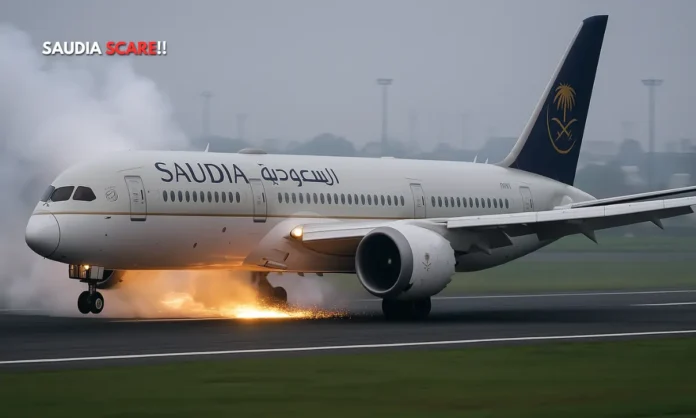SUMMARY
- 250 pilgrims escape harm as Saudia flight’s wheel overheats on landing
- Sparks, smoke trigger swift ATC and fire crew response at dawn
- Hydraulic leak blamed, raising safety concerns amid tense aviation week
Foam on the Tarmac: A Week of Flying Dangers
In a tense aviation week already marked by the deadly Air India Dreamliner crash in Ahmedabad, another narrow escape unfolded on June 16 in Lucknow. Saudia Airlines flight SV 3112, carrying 250 Hajj pilgrims from Jeddah, touched down at Chaudhary Charan Singh International Airport just after 6:30 am—only for smoke and sparks to erupt from its left landing gear seconds later. While no injuries were reported, the emergency prompted swift action: the pilot braked hard, ATC was alerted, and the plane was pushed to the taxiway where all passengers were safely deboarded.
Initial reports blame the scare on a sudden hydraulic fluid leak that led to overheating in the wheel assembly—a glitch that experts say could have been catastrophic had it occurred during takeoff. The incident adds to growing scrutiny of aircraft maintenance standards and safety preparedness at Indian airports, particularly during peak travel seasons like Hajj. That this follows so closely on the heels of a mass-casualty crash raises alarm not only about individual failures, but also about broader risk patterns in civil aviation. As Lucknow narrowly avoids tragedy, investigators and passengers alike are left with questions that foam and water alone can’t extinguish.
#BreakingNews
— The National Bulletin (@TheNationalBul1) June 16, 2025
A big accident was averted at Lucknow airport… Smoke started coming out due to a fault in the wheel of a Saudi Airlines flight while landing
There were 250 Haj pilgrims on board the plane. Everyone was safe due to the presence of mind of the pilot and the… pic.twitter.com/pwddz3CqRw
A Controlled Blaze
- Sparks and smoke were seen immediately after landing
- ATC responded within seconds, ensuring no further escalation
- Emergency crews used foam and water to cool down the overheated wheel
- The entire evacuation was completed without injury in under 30 minutes
- Hydraulic leak pinpointed as cause of the overheating
Unlike the catastrophic crash in Ahmedabad days earlier, Lucknow’s Saudia flight SV 3112 incident ended without bloodshed—but not without fear. The aircraft had just touched down when flames and smoke flared from its left wheel, pushing the airport’s emergency response into high gear. Within moments, the pilot called for assistance, ground teams isolated the aircraft, and foam cannons were deployed to prevent ignition.
Lucknow airport’s crisis protocol worked as designed. No passengers were harmed, and the flames never turned into fire. But experts caution that while this was a technical win, it also exposes how narrow the margin for disaster can be. A simple hydraulic malfunction—often buried deep within a jet’s maintenance checklist—can endanger hundreds, especially in high-stakes flights like those ferrying Hajj pilgrims.
Pilgrim Safety vs. Peak Pressure
- The flight carried 250 Hajj pilgrims returning from Saudi Arabia
- Tensions are high due to increased air traffic during Hajj
- SV 3112 was meant to return empty to Jeddah after dropping off passengers
- Older aircraft often rotate heavily during pilgrimage seasons
- Religious travel charters face unique logistical and risk pressures
Flights associated with major religious pilgrimages often operate under complex logistical loads and tight turnarounds—and this one was no exception. Saudia flight SV 3112 had brought 250 pilgrims home from Jeddah and was scheduled to fly back empty. Had the hydraulic failure occurred just an hour earlier, the results during takeoff would have likely been dire.
Experts in aviation logistics point out that pilgrimage season brings immense strain on aging fleets and overbooked routes. Aircraft that usually rest for long hours between flights are rotated quickly, often across international borders. This raises the stakes for every screw and sensor. And though the wheel flareup in Lucknow didn’t end in tragedy, it did expose how little room there is for error when moving hundreds of lives on time, across continents, in machines that rely on perfect coordination.
Systemic Smoke Signals
- Aviation authorities may launch a deeper probe into Saudia’s maintenance logs
- The event follows India’s worst air disaster in over a decade
- Public perception of air travel safety in India is increasingly shaken
- Calls for stricter checks on inbound international charter flights are growing
The Saudia flight Lucknow 2025 incident may not have claimed lives, but it did claim certainty—certainty that Indian airports can handle the surge in post-pandemic international traffic without error, and that foreign carriers operate to the same rigorous safety protocols as domestic airlines.
Given that the near-accident came within days of a massive crash in Ahmedabad, aviation watchdogs are likely to intensify checks—especially on international flights arriving under charter or religious travel programs. Maintenance logs may be re-audited, and new rules may emerge for technical oversight during high-stakes seasons like Hajj or Christmas.
In the eyes of the public, however, the takeaway is simpler: aviation is starting to feel less secure. Even when no one dies, the fire crews, the smoke, and the sudden stops are enough to fuel doubts that linger long after the runway clears.
Between Landing Lights and Warning Signs
Aviation isn’t just about safe landings—it’s about safe systems. And in the span of just a few days, India has seen both ends of that spectrum: a catastrophic crash in Ahmedabad and a narrowly averted one in Lucknow. While Saudia flight SV 3112 landed without injury, it landed with consequence. A hydraulic leak, a wheel overheating, and smoke on the tarmac—all of it was a reminder that even the best emergency responses can only react. The real question is: can India and its international partners prevent?
As thousands more pilgrims return from Hajj, and commercial travel rebounds, the time for reactive firefighting has passed. What Lucknow showed isn’t just technical success—it’s a warning flare. If ignored, the next “close call” might not be close at all.


